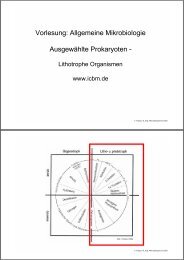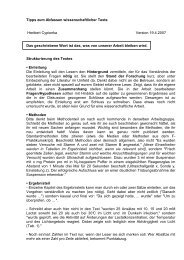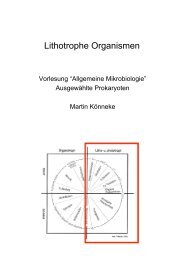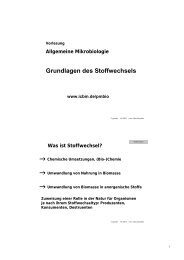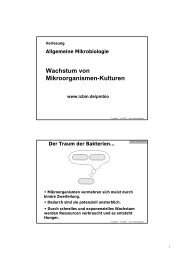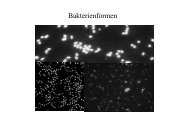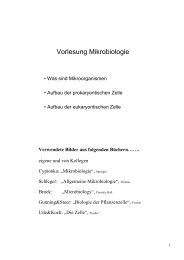Fungi – moulds, yeasts and mushrooms
Fungi – moulds, yeasts and mushrooms
Fungi – moulds, yeasts and mushrooms
You also want an ePaper? Increase the reach of your titles
YUMPU automatically turns print PDFs into web optimized ePapers that Google loves.
<strong>Fungi</strong> <strong>–</strong><br />
<strong>moulds</strong>, <strong>yeasts</strong> <strong>and</strong> <strong>mushrooms</strong><br />
© Anna Gorbushina, WS 2006/2007<br />
<strong>Fungi</strong> in microbiology<br />
(probably, you have heard these names already…)<br />
Applied microbiology <strong>and</strong> biotechnology<br />
Saccharomyces cerevisiae (beer, bread)<br />
Penicillium roquefortii (cheese)<br />
Penicillium chrysogenum <strong>and</strong> Acremonium chrysogenum<br />
(antibiotics)<br />
Aspergillus niger (citric acid)<br />
Haploid eukaryotes with fast growth rates<br />
Neurospora crassa<br />
Aspergillus nidulans<br />
Saccharomyces cerevisiae<br />
Ecology, physiology, diversity, plant pathology etc.<br />
© Anna Gorbushina, WS 2006/2007<br />
1
•Prokaryotes are morphologicall simple, but physiologically tremendously diverse<br />
•Planta, <strong>Fungi</strong> <strong>and</strong> Animalia have lived through this 3 domain transfromation with<br />
only minor alterations<br />
•Protists stay the most diverse group<br />
•<strong>Fungi</strong> traditionally includ true fungi <strong>and</strong> fungi-like protists<br />
Bacteria<br />
Archaea<br />
unicellular osmotrophic<br />
Protista unicellular diverse:<br />
ingestion, osmotrophic<br />
Animalia multicellular phagotrophic (ingestion)<br />
<strong>Fungi</strong> X-cellular osmotrophic<br />
Planta multicellular osmotrophic<br />
© Anna Gorbushina, WS 2006/2007<br />
© Anna Gorbushina, WS 2006/2007<br />
2
<strong>Fungi</strong> - what is treated by<br />
mycology?<br />
True fungi <strong>and</strong> fungi-like protists<br />
Microscopic organisms, but there are also<br />
huge fungi<br />
For classification it is necessary to have<br />
propagation structures or to use molecular<br />
biological characters<br />
© Anna Gorbushina, WS 2006/2007<br />
<strong>Fungi</strong> <strong>and</strong> mycology<br />
Groups traditionally treated by mycology<br />
Oomycetes<br />
Chytridiomycetes<br />
Zygomycetes<br />
Ascomycetes<br />
Basidiomycetes<br />
© Anna Gorbushina, WS 2006/2007<br />
3
Protozoa<br />
Mycetozoa<br />
Mesomycetozoa<br />
Chromista<br />
Oomycota<br />
Eumycota<br />
New classification<br />
Kingdom Protista<br />
Plasmodiophoromycota<br />
Dictyosteliomycota<br />
Acrasiomycota<br />
Myxomycota<br />
Oomycota<br />
Hyphochytriomycota<br />
Labyrinthulomycota<br />
Chytridiomycota<br />
Zygomycota<br />
Zygomycetes<br />
Entomophthorales<br />
Mortierellales<br />
Mucorales<br />
Ascomycota<br />
Archiascomycetes<br />
Pneumocystidales<br />
Hemiascomycetes<br />
Saccharomycetales<br />
Euascomycetes<br />
Chaetothyriales<br />
Clavicipitales<br />
Dothideales<br />
Eurotiales<br />
Hypocreales<br />
Leotiales<br />
Microascales<br />
Onygenales<br />
Ophiostomatales<br />
Phyllachorales<br />
Pleosporales<br />
Sordariales<br />
Basidiomycota<br />
Hymenomycetes<br />
Agaricales<br />
Stereales<br />
Tremellales<br />
Urediniomycetes<br />
Sporidiales<br />
Ustilaginomycetes<br />
Microstomatales<br />
Tilletiales © Anna Gorbushina, WS 2006/2007<br />
Ustilaginales<br />
Kingdom <strong>Fungi</strong><br />
Chytridiomycota<br />
Zygomycota<br />
Ascomycota<br />
Basidiomycota<br />
© Anna Gorbushina, WS 2006/2007<br />
4
© Anna Gorbushina, WS 2006/2007<br />
<strong>Fungi</strong> or How to define a diverse polyphyletic<br />
group (i)<br />
Heterotrophic (no photosynthesis)<br />
Osmotrophic (absorptive nutrition -<br />
exoenzymes)<br />
Cell walls with chitin<br />
Thallus grows in or on a substrate, is<br />
filamentous (or unicellular) <strong>and</strong> grows in<br />
modules<br />
Eukaryotic<br />
real nucleus, cells frequently multinuclear<br />
© Anna Gorbushina, WS 2006/2007<br />
5
<strong>Fungi</strong> or How to define a diverse polyphyletic<br />
group (ii)<br />
Life cycles diverse (from simple to<br />
complex)<br />
Sexual propagation may be present or<br />
absent<br />
Fruiting bodies (sporocarps) micro- or<br />
macroscopic, sometimes differentiated into<br />
tissue-like structures<br />
<strong>Fungi</strong><br />
eukaryotic, haploid (n)<br />
dikaryotic (n+n) <strong>and</strong> diploid (2n)<br />
periods<br />
unmotile<br />
an exception in <strong>Fungi</strong>: spores of<br />
Chytridiomycota<br />
Cell walls predominantly contain chitin<br />
(R=NH-CO-CH 3 )<br />
unicellular (yeast) <strong>and</strong> multicellualr<br />
(filamentous or mycelial fungi)<br />
Apical (tip) growth<br />
Spores as spreading <strong>and</strong> survival units<br />
© Anna Gorbushina, WS 2006/2007<br />
© Anna Gorbushina, WS 2006/2007<br />
6
Growth in hypha <strong>and</strong> yeast<br />
Fungal spores<br />
From Bartnicki-Garcia & Lippman, 1969, © AAAS<br />
Spread (propagation) <strong>and</strong> survival<br />
spread - quantity<br />
Survival - thick pigmented cell walls<br />
Asexual (mitotic division)<br />
Sexual (cell fusion <strong>and</strong> meiosis)<br />
Sometimes in fruit bodies<br />
Protection<br />
Spreading mechanisms<br />
Apical growth<br />
Transport<br />
system to the<br />
only growth<br />
zone - the tip<br />
Numerous<br />
vesicles with<br />
„building units“<br />
for cell wall<br />
synthesis<br />
Spitzenkörper<br />
Yeast - different<br />
distribution of<br />
growth zones<br />
© Anna Gorbushina, WS 2006/2007<br />
© Anna Gorbushina, WS 2006/2007<br />
7
Fungal fruiting bodies (sporocarps)<br />
Mushrooms-onlyfruit<br />
bodies<br />
Still composed of<br />
hyphae<br />
From Cooke&Rayner, 1984 (c) Longman<br />
© Prof. Trinci<br />
© Anna Gorbushina, WS 2006/2007<br />
Morphology of fungi - hypha, mycelium, colony<br />
•Mycelium has 1 to 10 µm in diameter<br />
•Tip growth<br />
•Substrate penetration<br />
•Substrate contact surface is enormous<br />
From Cooke&Rayner, 1984 (c) Longman<br />
© Polona Zalar & Nina Gunde-Cimerman<br />
© Anna Gorbushina, WS 2006/2007<br />
8
Morphology of fungi - vegetative mycelium<br />
modifications<br />
Fungal morphology<br />
Witch circle<br />
Mycelial str<strong>and</strong>s -<br />
Serpula lacrymans<br />
Sclerotia - mummified fruits,<br />
insect bodies, with mycelium<br />
penetrating all through<br />
© Anna Gorbushina, WS 2006/2007<br />
© Polona Zalar & Nina Gunde-Cimerman<br />
© Anna Gorbushina, WS 2006/2007<br />
9
General information<br />
Cell wall - chitin, cellulose, glucanes<br />
Motility: none (flagellate spores in Chytridiomycota!)<br />
Thallus - mycelial (septate, unseptate) or yeast<br />
Metabolism: aerobic, facultative anaeroby<br />
(fermentation)<br />
Life cycles<br />
Asexual (vegetative, mitotic spores)<br />
Sexual (generative, meiotic spores)<br />
Complex, usually facultative<br />
© Anna Gorbushina, WS 2006/2007<br />
© Anna Gorbushina, WS 2006/2007<br />
10
Oomycota<br />
Protozoa<br />
Mycetozoa<br />
Mesomycetozoa<br />
Chromista<br />
Oomycota<br />
Eumycota<br />
Chytridiomycota<br />
Zygomycota<br />
Zygomycetes<br />
Entomophthorales<br />
Mortierellales<br />
Mucorales<br />
Ascomycota<br />
Archiascomycetes<br />
Pneumocystidales<br />
Hemiascomycetes<br />
Saccharomycetales<br />
Euascomycetes<br />
Chaetothyriales<br />
Clavicipitales<br />
Dothideales<br />
Eurotiales<br />
Hypocreales<br />
Leotiales<br />
Microascales<br />
Onygenales<br />
Ophiostomatales<br />
Phyllachorales<br />
Pleosporales<br />
Sordariales<br />
Basidiomycota<br />
Hymenomycetes<br />
Agaricales<br />
Stereales<br />
Tremellales<br />
Urediniomycetes<br />
Sporidiales<br />
Ustilaginomycetes<br />
Microstomatales<br />
Tilletiales © Anna Gorbushina, WS 2006/2007<br />
Ustilaginales<br />
•Aquatic organisms<br />
•Water absolutely<br />
necessary (in soil, as<br />
l<strong>and</strong> plants parasites)<br />
•Heterokont, biflagellate,<br />
spores<br />
•Cell walls contain<br />
cellulose und glucan (ß-<br />
(1-3) <strong>and</strong> ß-(1-6)<br />
glycoside bonds<br />
•Oogamy with a complex<br />
<strong>and</strong> very specific<br />
fertilisation process<br />
•Phytophtora infestans<br />
© Anna Gorbushina, WS 2006/2007<br />
11
Protozoa<br />
Mycetozoa<br />
Mesomycetozoa<br />
Chromista<br />
Oomycota<br />
Eumycota<br />
Chytridiomycota<br />
Zygomycota<br />
Zygomycetes<br />
Entomophthorales<br />
Mortierellales<br />
Mucorales<br />
Ascomycota<br />
Archiascomycetes<br />
Pneumocystidales<br />
Hemiascomycetes<br />
Saccharomycetales<br />
Euascomycetes<br />
Chaetothyriales<br />
Clavicipitales<br />
Dothideales<br />
Eurotiales<br />
Hypocreales<br />
Leotiales<br />
Microascales<br />
Onygenales<br />
Ophiostomatales<br />
Phyllachorales<br />
Pleosporales<br />
Sordariales<br />
Basidiomycota<br />
Hymenomycetes<br />
Agaricales<br />
Stereales<br />
Tremellales<br />
Urediniomycetes<br />
Sporidiales<br />
Ustilaginomycetes<br />
Microstomatales<br />
Tilletiales © Anna Gorbushina, WS 2006/2007<br />
Ustilaginales<br />
Differences in<br />
propagation<br />
Sexual<br />
propagation (all<br />
around meiosis)<br />
Generations<br />
(sexual/asexual)<br />
© Anna Gorbushina, WS 2006/2007<br />
12
Some groups of <strong>Fungi</strong><br />
Chytridiomycota<br />
Zygomycota<br />
Ascomycota<br />
Basidiomycota<br />
Deuteromycota (<strong>Fungi</strong><br />
imperfecti)<br />
© Anna Gorbushina, WS 2006/2007<br />
Cell wall composition in phyla of fungi <strong>and</strong> fungallike<br />
protists<br />
Oomycota<br />
Chytridiomycota<br />
Zygomycota<br />
Ascomycota<br />
Basidiomycota<br />
cellulose<br />
β-(1-3)- <strong>and</strong> β-(1-6)glucan<br />
chitin<br />
β-(1-3)- <strong>and</strong> β-(1-6)glucan<br />
chitin<br />
chitosan<br />
chitin<br />
β-(1-3)- <strong>and</strong> β-(1-6)glucan<br />
chitin<br />
β-(1-3)- <strong>and</strong> β-(1-6)glucan<br />
glucan<br />
glucan<br />
polyglucouronate,<br />
glucuronomannproteins,<br />
polyphosphates<br />
galactomannoproteins<br />
α-(1-3)- glucan<br />
xylomannoproteins,<br />
α-(1-3)- glucan<br />
© Anna Gorbushina, WS 2006/2007<br />
13
Fungal nutrition <strong>and</strong> their<br />
presence in ecosystems<br />
Osmotrophic - with a huge reactive surface<br />
Organoheterotrophic<br />
Respiration/Fermentation<br />
Where they live: everywhere (soil, air, water,<br />
wood, rocks). Mainly aerated zones<br />
Strictly anaerobic fungus: only one<br />
Chytridiomycete Neocallimastix frontalis (39°C, pH<br />
6,5) known from the rumenal ecosystem<br />
© Anna Gorbushina, WS 2006/2007<br />
Hypha <strong>–</strong> mycelum <strong>–</strong> colony <strong>–</strong> fruiting body<br />
Mycelium important for all: parasites,<br />
symbionts, destruents<br />
Penetration <strong>and</strong> substrate colonisation<br />
Curious example: Nematode-trapping<br />
fungi<br />
© Anna Gorbushina, WS 2006/2007<br />
14
Fungal lifestyles<br />
Saprophytes on dead organic matter - „trash<br />
<strong>and</strong> litter“ :<br />
soil (1g of agricaltural field soil contains<br />
10-100 m of fungal mycelium)<br />
wood (destruction <strong>and</strong> staining)<br />
various organic compounds<br />
Symbionts with bacteria, algae, plants<br />
Parasites on animals, algae, plants<br />
SAPROPHYTES<br />
•Substrate mycelium, exoenzymes,<br />
osmotrophy<br />
•Available nutrients<br />
© Anna Gorbushina, WS 2006/2007<br />
-carbohydrates including highly polymeric<br />
(cellulose, starch, pectine, lignine)<br />
-proteins (including keratin)<br />
-fats, polyols etc<br />
© Anna Gorbushina, WS 2006/2007<br />
15
PARASITES<br />
•Direct contact <strong>and</strong> nutritional<br />
connection<br />
•Mycelium on the surface of a<br />
structure (e.g. leaf) or between the<br />
cells<br />
•Always a direct contact between<br />
cytoplasmatic membranes -<br />
penetration structure „haustorium“<br />
PARASITES<br />
•Metabiotrophic<br />
•Biotrophic<br />
•Necrotrophic<br />
© Anna Gorbushina, WS 2006/2007<br />
© Anna Gorbushina, WS 2006/2007<br />
16
Claviceps purpurea - sclerotia<br />
SYMBIONTS<br />
Obligate life cycle -<br />
perfectly adapted to the<br />
host‘s life cycle<br />
Infection is very limited -<br />
only one corn<br />
Sclerotia are survival<br />
structures (winter winter), ), after<br />
that a proper meiotic<br />
cycle takes place<br />
Various biologically active<br />
metabolites (LSD)<br />
Mycorrhiza <strong>–</strong> higher plants (trees, grasses,<br />
orchids)<br />
Lichens <strong>–</strong> algae <strong>and</strong> /or cyanobacteria<br />
© Anna Gorbushina, WS 2006/2007<br />
© Anna Gorbushina, WS 2006/2007<br />
17
Mycotrophy of higher plants<br />
• 80% of plant species are obligately mycotrophic, 10% -<br />
facultatively<br />
•<strong>Fungi</strong> form a close contact with plant roots either as a coat<br />
or between the root parenchyme cells<br />
•Characteristic morphology <strong>and</strong> physiology<br />
Mycorrhiza<br />
Mutual profit<br />
Water, P-, N- <strong>and</strong> Ca-compounds for a<br />
plant partner<br />
Carbohydrate for a fungal partner<br />
What happens on a contact interface?<br />
Hyphae are digested<br />
Phosphatases of plant<br />
Glucose und succrose are transformed into<br />
trehalose und mannitol<br />
© Anna Gorbushina, WS 2006/2007<br />
© Anna Gorbushina, WS 2006/2007<br />
18
Ectotrophic mycorrhiza<br />
Fs <strong>–</strong> fungal sheath (Mantel aus Pilzhyphen, die auch<br />
außerhalb der Wurzel weiter in den Boden wachsen)<br />
Hn <strong>–</strong> Hartig‘s net (Myzel zwischen den Zellen)<br />
Mycorrhiza stimulates growth of plants<br />
© Anna Gorbushina, WS 2006/2007<br />
See also: Smith, S.E., Smith, F.A. & Jakobsen, I. (2003) Plant Physiol. 133: 16-20.<br />
© Anna Gorbushina, WS 2006/2007<br />
19
Ectotrophic<br />
mycorrhiza makes<br />
phosphorous<br />
available, also<br />
including<br />
phosphates from<br />
mineral soil<br />
horizons<br />
L<strong>and</strong>eweert, R., Hoffl<strong>and</strong>, E., Finlay, R.D., Kuyper, T.W. & Van Breemen, N.<br />
(2001) Trends Ecol. Evol. 248-253.<br />
© Anna Gorbushina, WS 2006/2007<br />
Lichen thallus<br />
Form <strong>and</strong> structure are<br />
determined by a mycobiont<br />
Cortex (upper <strong>and</strong> lower)<br />
Photobiont layer<br />
Medula<br />
Flavoparmelia caperata<br />
© Anna Gorbushina, WS 2006/2007<br />
20
<strong>Fungi</strong><br />
Diverse<br />
Ubiquitous <strong>and</strong> stress-tolerant<br />
With a huge potential (enzymes,<br />
secondary metabolic products)<br />
Important in nature as destruents<br />
(recyclers), symbionts <strong>and</strong> parasites; as<br />
lichens even as primary producers<br />
Biotechnologically useful<br />
© Anna Gorbushina, WS 2006/2007<br />
In the real world, the estimate of fungus biomass<br />
is about two tons per human being in the overall<br />
biosphere. The unseen underground feeding<br />
mechanisms of fungi are the great recyclers:<br />
autumn leaves, cornstalk debris, mountains of<br />
trash, all returned to usable form mainly by fungi.<br />
No soil fungi, no trees <strong>and</strong> forests as we know<br />
them. No waving fields of grain. No escape from<br />
unforeseen pneumonia. No athlete's foot. No<br />
bread, no booze. Give us non-mushroom<br />
mycologists a break!<br />
Dr. Emory Simmons<br />
© Anna Gorbushina, WS 2006/2007<br />
21
Zygomycota<br />
Zygomycota<br />
Chitinous cell<br />
walls<br />
Spores in<br />
sporangia<br />
Survival<br />
structures -<br />
zygosporangia<br />
© Anna Gorbushina, WS 2006/2007<br />
Sugar fungi<br />
Insect<br />
parasites<br />
Symbionts<br />
(VAM<br />
Mykorrhiza)<br />
© Anna Gorbushina, WS 2006/2007<br />
22
Ascomycota<br />
The biggest group<br />
Chitin, all protective<br />
pigments<br />
Spores asexual <strong>–</strong><br />
exogenous; sexual <strong>–</strong> in<br />
Asci<br />
Ascomycota<br />
Parasites (true mildew)<br />
Symbionts (lichens,<br />
mykorrhiza)<br />
Destruents<br />
© Anna Gorbushina, WS 2006/2007<br />
© Anna Gorbushina, WS 2006/2007<br />
23
Basidiomycota<br />
Chitin<br />
Dikaryotic<br />
phase<br />
(reproductio<br />
n process is<br />
prolonged)<br />
Spores<br />
exogenous<br />
on a<br />
basidium;<br />
basidia<br />
(plural) on a<br />
fruit body<br />
Basidiomycota<br />
Saprotrophs<br />
(wood<br />
decomposers)<br />
Parasites<br />
(living hosts,<br />
also trees)<br />
Symbiontes<br />
(mycorrhiza)<br />
© Anna Gorbushina, WS 2006/2007<br />
© Anna Gorbushina, WS 2006/2007<br />
24
Protozoa<br />
Mycetozoa<br />
Mesomycetozoa<br />
Chromista<br />
Oomycota<br />
Eumycota<br />
Chytridiomycota<br />
Zygomycota<br />
Zygomycetes<br />
Entomophthorales<br />
Mortierellales<br />
Mucorales<br />
Ascomycota<br />
Archiascomycetes<br />
Pneumocystidales<br />
Hemiascomycetes<br />
Saccharomycetales<br />
Euascomycetes<br />
Chaetothyriales<br />
Clavicipitales<br />
Dothideales<br />
Eurotiales<br />
Hypocreales<br />
Leotiales<br />
Microascales<br />
Onygenales<br />
Ophiostomatales<br />
Phyllachorales<br />
Pleosporales<br />
Sordariales<br />
Basidiomycota<br />
Hymenomycetes<br />
Agaricales<br />
Stereales<br />
Tremellales<br />
Urediniomycetes<br />
Sporidiales<br />
Ustilaginomycetes<br />
Microstomatales<br />
Tilletiales © Anna Gorbushina, WS 2006/2007<br />
Ustilaginales<br />
Ameboid slime <strong>moulds</strong> - Protista<br />
neither slimy, no <strong>moulds</strong><br />
no hyphae<br />
no cell walls in the trophic phase<br />
in the trophic phase ingestion or<br />
phagocytosis<br />
fruiting bodies with cell walls<br />
Spores as propagation units<br />
amoebal or plasmodial vegetative phase<br />
© Anna Gorbushina, WS 2006/2007<br />
25
Ameboid slime <strong>moulds</strong> - Protista<br />
Acrasiomycota: early separation from<br />
Eukarya - discoidal mitochondrial cristae<br />
Myxomycota <strong>and</strong> Dictyosteliomycota <strong>–</strong><br />
later development, unrelated<br />
tubular mitochondrial crystae<br />
Numerous differences in morphology, life<br />
cycles, flagella, cell wall composition,<br />
nutrition<br />
© Anna Gorbushina, WS 2006/2007<br />
Plasmodium Physarum polycephalum<br />
© Anna Gorbushina, WS 2006/2007<br />
26
Different types of sporangia in<br />
myxomycetes<br />
Trichia decipiens<br />
Physarum cinereum<br />
Ameboid slime <strong>moulds</strong><br />
Pigments, heterotrophic (no<br />
chlorophyll)<br />
Net-work like structures<br />
that creep over substrates<br />
<strong>and</strong> are capable of<br />
phagocytosis<br />
rhythmic plasmamovements<br />
over cmdistances<br />
Fruiting bodies (sporangia)<br />
Diachea leucopodium<br />
Stemonitis<br />
fusca<br />
© Anna Gorbushina, WS 2006/2007<br />
© Anna Gorbushina, WS 2006/2007<br />
27



